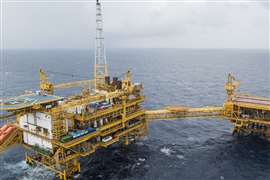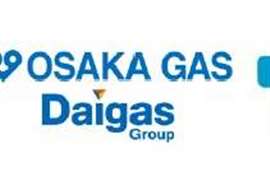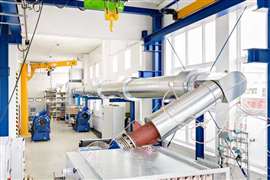CherCo sees new opportunities for contract compression
November 29, 2022
 Chet Erwin
Chet Erwin
New ventures can be risky, but with experienced managers and ample capital backing them up, there are clear opportunities for growth. Chet Erwin, the new chief executive at the recently formed contract service provider CherCo, is betting a growing natural gas industry can provide steady returns for contract services providers.
Although CherCo itself may be a new player, Erwin, has more than 35 years of experience starting and expanding successful companies in the energy sector. He co-founded Hanover Compression Company, which started as a four-person Texas operation in 1990 and grew to more than 5,000 employees worldwide by 2001.
In 2004, he co-founded Valerus Compression Services, which grew its revenues in five years to become the second-largest gas-handling, service company worldwide.
Whitehawk Capital Partners saw potential in CherCo and recently provided $55 million of financing into the company along with CherCo’s investors which enable expansion in the U.S. Southwest.
In addition to compression equipment, CherCo offers service guarantees, mechanical availability and timely service from some of the top mechanics in the industry. Comprised of the latest-model Caterpillar and Waukesha engines with Ariel and GE compressors, CherCo’s fleet of equipment is suited for gas lift and gas sales in addition to midstream gathering, gas processing and treating.
The firm’s warehouses and operating locations are strategically located to provide customers fast response times. CherCo technicians are dedicated to its customers’ aftermarket service needs. state-of-the-art training and parts distribution throughout the company’s operating footprint.
COMPRESSORtech2 recently sat down with Erwin and its chief financial officer Braden Norris to discuss the opportunities in the coming years for gas compression service providers.
Can you tell us a bit about CherCo and how it came to be?
CE: I’ve been in the gas compression business since about 1985 and there was a company in east Texas called CherCo Compression. They were one of original adopters of the contract compression space. I liked the name and I set up a company called CherCo several years ago, just as a personal company.
Braden and I when we went down this path to look at opportunities in the compression space we used CherCo as a placeholder as we were thinking we would buy somebody and assume their name, but ultimately we ended up with CherCo.
Our very first day of business was September 1 of this year. Braden and I teamed up in 2020 to start looking at opportunities in the infrastructure service contract compression space. We looked at a lot of companies and several regional companies.
Ultimately, our transaction was a carve out of operating and idle assets from one of the large publics in our space. Then we acquired a small regional compression company based in Longview, Texas and the owner has since come on board to be part of the CherCo team.
Then as part of the general strategy we bought a lot of idle assets from a large midstream company. So at closing, we had about 210,000 hp in our fleet.
It’s a nice start, a great operating footprint starting in South Texas, Central Texas, East Texas and Louisiana.
We are developing our Permian Basin strategy. We will take a lot of our large horsepower gas lift equipment to the Permian Basin in the later part of this year and in 2023.
 Braden Norris
Braden Norris
BN: The way I like to think about it is if you look at a map and draw a line down half of Texas the Eastern half of Texas and the state of Louisiana was the active operating footprint that we acquired.
CE: With the transaction, we have just under 100 customers. That was part of the attraction to the operating assets, which came with great customers. Our strategy is to work with new and existing customers to further develop those relationships and help increase the utilization of our fleet.
What did your agreement with Whitehawk provide?
CE: It allowed us to complete those acquisitions and to provide some additional financing for future transactions. We put ample cash on the balance sheet, to allow us some flexibility to transact on other opportunities or to modernize our fleet. We have a lot of opportunities.
What long-term trends do you see in the industry?
CE: The base case for gas compression hasn’t changed in 100 years. That is taking gas from the wellhead, through the gathering system and ultimately into the pipeline. So as the infrastructure around the country continues to be developed, the demand for gas compression will remain strong for decades to come.
What is different?
CE: There are a couple of things that stand out. First and foremost, the demand for large horsepower gas compression is a trend that has been very meaningful over the last five years, particularly in the Permian but also in other areas. These multi-well pads are very common in the gas compression space.
When I think about the future of the natural gas business, there is about 10 Bcf/d of LNG capacity, which makes up about 8% of the 118 Bcf/d produced in the U.S. today.
So just under 10% of U.S. production today is going to LNG. Within five years, with the existing plants that are permitted, that will double. The demand for LNG will go from 10 Bcf/d to 20 Bcf/d and who knows what the total volume of domestic consumption will be, but it is a game changing event for the natural gas industry. We are at the heart of the production and transportation of natural gas. We are very excited about the future of the infrastructure services space.
BN: To add to that, these export facilities have changed the natural gas industry. Historically we have been focusing on supplying the domestic consumption of natural gas. With these export facilities, it takes supply to a global market. Look across to European gas prices today. They are four and five times what we see domestically.
What holds the U.S. from helping to lower that cost overseas is our export capacity or lack thereof to fully participate in a global marketplace. On question we constantly monitor is ‘Will these export facilities allow the U.S. the capacity to play a larger role in the global market and what will that do for domestic prices?
We feel that the growth of LNG will help create more stability in gas prices in the long term. The chances that we see gas prices return to where they were in 2016 levels is unlikely.
We’re doing what we can, but we’re operating at peak capacity. There is an equilibrium that we will hit at some point on a global level which makes us excited for the long-term outlook for natural gas.
What other new trends?
CE: There is a clear trend for gas compression fleets to move to larger horsepower. In the mid 1980s, the average horsepower was 120 to 150 horsepower. My general sense across the board is that it is around 500 horsepower. The large players like Archrock, USA Compression and Kodiak are focused solely on large horsepower. So the one thing that is different about our strategy is that we want to be able to provide compression services from the wellhead to the pipeline.
Our smallest unit is 100 hp and our largest is just under 1700 hp. We want to be able to provide our customers compression services up and down the horsepower spectrum. One day they will need 100 hp and another day, they will need a 1600 hp machine. We want to provide them that service from the wellhead to the pipeline.
Do you think the contract compression space has gotten more crowded or is there still room for new players?
CE: There is always room for someone who can provide a quality service. The demand for compression horsepower grows every year as consumption grows. So whether it’s a new company like CherCo or a large one of the large publics in our space, the demand for horsepower is very consistent and predictable. We are bringing significant horsepower to the market over the next couple of years, so we think that will be very well received with the service component that CherCo brings to the market. We offer full service contract compression.
What advice would you have for a young person interested in the gas compression industry?
CE: I tell young people in general that this is an industry that will be in demand for decades to come. Don’t be concerned about the volatility of the energy space because natural gas infrastructure and natural gas infrastructure services have proven to be resilient. The industry as a whole needs young people to come in and replace my generation of people who have now retired. There is a long successful future here.
You have to think about the business differently than in 1985 when I started. ESG and compliance around emissions are paramount to our success. This is the future of the industry and we need to embrace it. CherCo will certainly be a part of that. We think about safety and operations first and foremost. There is a lot of change in the industry, but it is change in the industry that has been very consistent over the years. The new change is the ESG component and you have to embrace it and make it part off your culture.
What keeps you up at night?
CE: Supply chain issues are very real. We can’t take for granted some of the most simple products that we used over the years. Engine deliveries from Caterpillar take 52 to 56 weeks -- and up to 70 weeks on specific models.
There is a tremendous series of supply chain issues for new packages. The daily items that we’ve always had at our fingertips, you can’t take those for granted anymore.
Our equipment runs 24/7 as our culture is committed to our customer’s success. We’re always trying to grow and upgrade our team with the most accomplished field operators possible.
BN: From a supply chain perspective, even the most simple of items have become difficult. Think about trucks, for example. Before, I could go down to a dealership and get a truck. Today, if I want a truck, I may have to search 20 dealerships and still not be able to find one, you have to plan well in advance of your needs. And that’s just one example.
Where are we headed in the next couple of years?
CE: The pandemic put a lot of projects on hold. Over the next two or three years, we expect pipeline companies to bring those projects forward. The industry is now reacting to that and I think we will play catch up for the next couple of years.
In addition, LNG has been part of our market for several years, but one news item that caught my attention was an LNG supply contract for 20 years. And I thought “These people are locking into a 20-year agreement.” LNG was something that was usually traded on the spot market. That contract put a lot of focus on the long-term. In addition, you have these new LNG projects that are coming online. This is not a flash in the pan.
The industry has been waiting for this for a long time. Each one of those plants will export 1 Bcf/d or 2 Bcf/d. Now we’re up to 10 Bcf/d with more coming. The trend around LNG and the positive noise is finally here and it will stabilize our natural gas industry, our country and our economy.
MAGAZINE
NEWSLETTER

CONNECT WITH THE TEAM








